They say that there are three sides to every story: yours, mine, and the truth. When it comes to hockey, and blogging about hockey, nothing seems more accurate.
And then, if you are a blogger at the Fanhouse, you can apply that principle with the other blogging stalwart: If it worked once, do it again and again.
First, Adrian Dater (again with the Dater) is reporting in his blog that the Avalanche are finally doing something they should have done a few years ago:
Just got off the phone with Kroenke Sports, and they will be selling upper bowl tickets for $20, starting noon on Wednesday at the Pepsi Center box office, for Wednesday’s game against the Chicago Blackhawks.
You read that right, $20 upper bowl tickets. As Lewis Black once said about the tax rebate, “Free at last, free at last.” Dater goes on:
What does this say? It says that the Avs, once the toughest ticket in this town, are getting desperate to fill the building again, by any means necessary.
We’re almost into February, and the Avs are having to off-load tickets at bargain rates against an Original Six team.
I have to say, Adrian Dater has become a pretty decent hockey blogger. “Desperate?” Punching the keywords of doom and gloom to get the reading public on board. Perfect. If you break out your hockey blogger thesaurus, desperate = any reason for change.
The story here is that they are, so far, only doing it for one game, doing it the day of the game, and only for the upper bowl (no, I do not think they should have $20 lower bowl, come on). In other words, not enough to make a huge impact, and a target audience of people who are making the game a last minute decision. While we are at it, who cares if the Blackhawks are an Original Six team or not? Why is that a draw? They can’t sell in their own arena, why would they sell in Denver? What I see is a test run, to determine whether or not ticket prices can be linked to butts in seats. I have news for Kroenke Sports (who own the Avs, Nuggets, Rapids (soccer), Mammoth (lacrosse), and more), it can. If you can not afford to pay the price for a ticket, you do not go. It’s really as simple as that. Of course, price is not the only factor to go into the decision of going to a game. But I will get into that in a moment.
On to the Fanhouse, where Greg Wyshynski, in a post titled “Support for Avalanche Rapidly Melting,” picks up on the ticket price reduction, and runs with it:
Dater writes that Denver’s economic downturn is a primary factor, but it’s not like the Avalanche were fleecing fans to begin with. The last Fan Cost Index from Team Marketing Report had Colorado below the League average and even the Islanders and Blue Jackets. The Avs are currently in the eight hole in the West; that, and their slew of injuries clearly have fans feeling pessimistic.
OK, make that slowly staggers away with it. The Fan Cost Index? What the FCI is barely adequate for is determining the cost of going to a game, and spreads it out over the entire arena. It talks about the average cost, which includes the cost of beer, hot dogs, a hat, parking, and a program. It’s an overview, but a selective one. More on the FCI in a moment.
Lets take a look at some real numbers. Here are screen captures from the latest ticket sales numbers from some of the up and down teams in the league. These are taken from Ticketmaster.com, today, for the next home game, be that today, or nest week.
Detroit Red Wings (who are also having attendance problems):
Pittsburgh Penguins (who are selling out left and right):

Nashville Predators (again with the attendance woes):
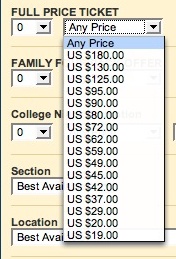
Anaheim Ducks (who have a serious sellout streak going on):
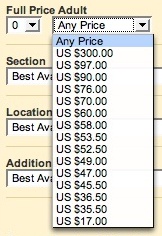
New Jersey Devils (who’s attendance the very next Fanhouse article is about):
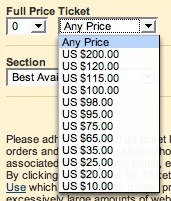
Minnesota Wild (who sell pretty well, the understatement of the year):
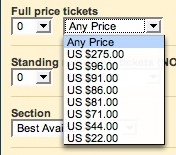
OK, let’s get back to the matchup of the Blackhawks and the Avs, where this whole debate started.
OK, now that we have the numbers (and this is only a sampling, but a decent cross section of teams on either end of the spectrum), what sticks out? First off, aside from the Penguins, who are selling out games left and right, the Avs have the highest ticket price at the bottom of the chart. They are two dollars more than the Minnesota Wild, who are selling out games left and right, and the Detroit Red Wings, who have attendance problems of their own. But let’s say that you don’t want to sit on the end of the rink, within five rows of the top of the building. The next tier of prices for the Avs is a $14 increase. The ticket price increase for the Ducks is higher ($18.50), but that next-level ticket is still cheaper than the Avs next level ($38.00 for the Avs, $35.50 for the Ducks).
Where does the FCI fall apart? Remember, we are talking average ticket price. Looking at the top prices of the list, the Ducks ticket price tops out at $300, the Avs at $209, the Blackhawks at $275, the Penguins at a measly $150, and the Red Wings at $85. Remember, these are the prices given by Ticketmaster, today. The averaging of ticket prices for a game is nearly impossible to calculate. A better calculation would be seat price versus seat location. How do comparable seats in various arenas price out? Look at the jump in price for the Blackhawks, from $85 to $275, between the top price and second to top. A similar story is seen in Minnesota. While the trend is not tracking between price and ticket sales, it does show how the average ticket price can be thrown out of sync with the rest of the teams in the league.
The NHL has always stipulated that ticket prices are based on what the market can sustain. If the market can not afford the price of the tickets, or if there is not enough value for the money, ticket prices drop. If tickets are in high demand, the price will go up, and the people selling the tickets will test the limits of the market. If that’s the case. believe me when I say, the Avs have found that limit. It wasn’t that long ago the sellout streak at the Pepsi Center came to an end. In fact, it was just last year. Ticket prices, against the odds, are still priced as though the streak continues. Something had to give, and this could be the start.
When I was in Detroit, I got into a conversation about the Red Wings and their “attendance woes” with a man who was not, by his own admission, a hockey fan. He was trying to figure out ways for the Wings to sell more tickets. His angle was a better delivery system, something digital, something with cell phones. I told him only one thing would work, lower ticket prices. And the funny thing was, he didn’t want to hear it. He thought there was some gimmick that would make the whole thing better, some way of making the ticket buying cooler, and more enjoyable. I had to break it down for him: Best record, hottest goalies, winning games at home, passionate fans, players the fans love. Every factor you could want in a hockey team, every factor a fan could want to in their team. And still they weren’t selling. What else was there to do?
Take away those factors by half, and you have the situation that the Avalanche are in (good home record, fan favorite players who are injured, decent home record). Add to that the sports budget stretched farther than ever in Denver, thanks to the World Series run of the Colorado Rockies (which had never happened before), and injuries decimating the roster (Tyler Arnason is the top center right now), and you have plenty of reasons not to go to the games. But even with that, the number one factor for going to a game is if you can afford it or not. If you do not have the money, you do not go. Simple.
Here’s a line that tickled me pink from Wyshynski’s post:
Last month, Jes Golbez lit a powder keg on FanHouse with a post about the eroding attendance numbers for the once-infallible Colorado Avalanche, covering everything from the argument that the team has too few stars to the debate about the effect the League’s national TV ratings have on Denver.
You know, that made me laugh. “Everything?” Not even close. While Golbez piled on the the snark, he left out the biggest reasons people may not want to pay to see a game (or any event, for that matter). Fan experience and value for money. I don’t know if Greg or Jes have ever attended a game at Le Can, but I certainly have seen my fair share from the last season, and can talk about the experience and value I got for my money. And if you do not think it’s worth the price of admission, you aren’t going to go.
While on the subject, if you are going to read the articles put out on the Fanhouse, you should also take a moment to read this post by Jibblescribbits. On the Fanhouse, it is called a “furious rebuttal,” I would say it was a “researched rebuttal.” In the immortal words Brian Regan, “They’re using numbers and stuff.”
Let me say that I do not endorse the ticket prices laid out by the Colorado Avalanche, or Kroenke Sports. It think they have been way too high for too long, and think they should have lowered ticket prices as soon as the lockout ended. If not then, certainly the season after. Doing this now, and for only one game, shows a misjudgment of the overcrowded Denver sports market.
If you trust the FCI, and want to pull numbers from it, then you can see that the Avs ticket price did not change from the 2005-06 season, to the 2006-07 season. Which is what the FCI is measuring, not the current season. That’s right, they are a season behind. So know what you are getting into when you look at their charts. This comes from the bottom of the FCI:
Average ticket price represents a weighted average of season ticket prices for general and club-level seats, determined by factoring the tickets in each price range as a percentage of the total number of seats in each stadium. Luxury suite sales are excluded from the survey. Season-ticket pricing is used for any team that offers some or all tickets at lower prices for customers who buy season tickets. Costs were determined by telephone calls with representatives of the teams, venues and concessionaires. Faxes were sent to verify the information supplied. Identical questions were asked in all interviews.
How realistic is this? For the average hockey fan, and not the season ticket holder, highly unrealistic. And the FCI is based on season ticket prices, not the prices for fans like you and I. Season tickets are a constant for hockey teams, and are not where attendance woes are coming from, nor where this current ticket price cut is aimed at. The FCI isn’t high on my list of useable sources.
This has all taken about as much research as rolling out of bed. Don’t get me wrong, I like Greg Wyshynski. I met him at the NHL Draft this past year in Columbus, and think he is a good writer and a nice guy. But I really think he should have done a better job on this one. Looking at the FCI, quoting Dater, and rolling the eyes is not good enough. Then again, this is hockey blogging. Research does not get people reading like snark. So maybe it is.

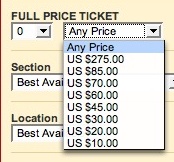

7 responses to “Avalanche Attendance: Woe is Everyone”
First of all, thanks for the time and consideration in the post. As a Devils fan, I know how touchy attendance talk can be.
My FanHouse post was mainly to point readers to the alarmist tone of a Denver beat writer regarding the Avs’ attendance. When a guy like Dater — who isn’t exactly Larry Brooks when it comes to hyperbole — analyzes the Colorado price cut as “Desperate,” then that’s news.
You’ve done a great job here explaining the high cost of hockey tickets. But I wonder how much attention you and other Colorado fans gave this pressing issue during the 487 straight games in which every seat was filled.
Your critique of the FCI was interesting, but it remains the standard for sports business analysis. I was merely using it to show that, compared to the rest of the NHL, a night out watching the Avalanche wasn’t exceptionally more expensive than seeing any comparable team. But I’ll take your concerns about it as a source under advisory.
One of the passages from my post you didn’t cite:
“This was a sensitive, multi-faceted issue that could say something greater about the current course of the franchise, rather than simply counting how many fannies are filling the seats.”
Your rebuttal seems to be several variations of “it’s the economy, stupid”; yet that doesn’t account for season ticket declines that began in 2006, according to the Denver Post. Was that the lockout? The lack of the same kind of star power the Avs had in the glory years? That, over a decade in Denver, some of the shine is off the franchise? Like I said on FanHouse — there are a number of reasons why the team is seeing empty seats and slashing prices. I’m just not ready to concede that it’s primarily an economic problem when economics weren’t an issue for over a decade.
I can see how it might seem we’re piling on the franchise, with my Dater post following my friend Jes’s blowtorch of a blog last month. It’s not my intention; but clearly there’s something happening in the previously impervious Denver hockey market that demands the same kind of attention we’ve given eroding gate in Detroit.
But hey: To each his own. These dust-ups are why we’re bloggers. Not disrespect on either end of the conversation, I hope.
Greg – I can imagine that the situation with the Devils is getting old for you.
Some of my criticism had to do with Dater, but most of my criticism has to do with your post, and to a point, Jes’. Dater has is doing what most bloggers and online writers do, use extremism and alarmist language to hammer home a point. I see it all the time in hockey blogging, the title of your post being a prime example, and it should get called for what it is.
Remember, Dater wasn’t quoted as a beat writer, he was quoted as a blogger. His hockey blog is very separate from his regular journalism. He can’t combine the two, as they are two separate gigs. If he did, he would have to compromise his journalism side. It’s a debate for another day, how the MSM dances between the blogging side and the journalism, but he was not using “desperate” in his column.
The economy is only part of what determines ticket prices. The economy in Denver now is not the same as the economy over the last ten years. It never is, anywhere. The prices in Detroit are much lower than in Colorado, and they still have problems. What I did was show that, and do the work to say what the situation is not. I’m OK with wild speculation, like the Jes post, but the numbers you were looking at were last year’s numbers, and weren’t the target of this price stynt. . And those certainly aren’t the numbers that the people who set the ticket prices are looking at. Mine probably aren’t either, but mine are current, easy to find, and useful. The numbers you used aren’t. It’s another side of the story, and one that I think was ignored in the brief post on the Fanhouse.
I don’t think you guys are piling on the franchise. It’s “news,” or debate, or part of the conversation. Keeping the hockey teams honest is a part of hockey blogging. As part of the conversation, you are going to get dissent. I hope I made it clear in my post that I like your writing, and I like you as a person. I will, being and Avs fan, defend those of us who attend the games, and pay good money, sometimes after bad, to see the games. And if I think the research can use some work, I’m more than happy to say so.
In fact, I’m calling out the Fanhouse right now. Do better research next time there is a post about attendance. Do more research, at least. There are plenty of numbers out there, they are easy to find, and with a little creativity, there can be some interesting reading. Too often, the post about attendance lead with snark, and finish with little else. It’s well past time for the Fanhouse to step it up. Anyone can do snark. Jes gets called out for lack of research in his post about the Devils attendance. If the bloggers are going to keep the hockey teams, league, and MSM honest, or at least on their toes, there is no reason you guys can do the same.
There are a lot of factors involved, and I don’t know them all. I think Jes was correct in a few of his assumptions and speculation, but has very little understanding of a city that has more than one sport, such as Denver. But again, any research would have helped his cause. Where was the complaining about ticket prices when they were selling out? Buried behind the rah-rah of a sellout streak. If the tickets are selling, what’s the problem, right? A family of four was still rarely able to afford the tickets, and when they could, the had to pick and choose when they went to games. There wasn’t as visible opposition because everything was status quo. Problem? What problem?
Just so you know, I mulled over this post all day. I reread it and reread it. I wanted to make sure I wasn’t just being a jerk, and had something to say. I think I did. No disrespect taken or given.
Remember, Dater wasn’t quoted as a beat writer, he was quoted as a blogger. His hockey blog is very separate from his regular journalism.
I haven’t read Dater enough to know this, although his quickly-deleted anti-ESPN tirade might have been a tip-off. If that’s how he approaches the gig, or how the Denver Post views it, what a joke — he’s the beat writer no matter where he’s writing, and calling a marketing scheme “desperate” is a news-maker for someone like me that doesn’t understand the hack logic of his many roles.
Do better research next time there is a post about attendance. Do more research, at least. There are plenty of numbers out there, they are easy to find, and with a little creativity, there can be some interesting reading. Too often, the post about attendance lead with snark, and finish with little else. It’s well past time for the Fanhouse to step it up.
Well, there are going to be posts that are a little more in-depth (http://sports.aol.com/fanhouse/2007/12/03/trashing-the-charity-point-re-imagining-the-nhl-standings) and ones that simply point readers to interesting trends or stories in the MSM and blogosphere. I thought Jes had already gone balls-deep on the Avs attendance; my post was about Dater’s analysis. But point taken — I think anytime attendance comes up, it should be handled with a little more attention to detail.
Where was the complaining about ticket prices when they were selling out? Buried behind the rah-rah of a sellout streak. If the tickets are selling, what’s the problem, right?
Sorry, I’m still not buying this. You don’t pack the house for a decade — when other franchises were in attendance decline — if the ticket prices are that out of hand or unreasonable. I think they’ve become a problem now due to other factors — the lockout, the Avs’ on-ice success and the changing face of the team.
But like I said, Tape – agree to disagree. I think, at the end of the day, we can still get together as bloggers-in-arms and have you buy me a beer. 😉
Greg – I’m not saying the product wasn’t better in the time of the sellout streak. I do think that’s part of it, but as I stated in the post, the ticket prices do not reflect the product. They should have lower the ticket prices before this, and they are paying the price. What Dater calls desperate, I call about time.
But the numbers do show a serious side of the problem, one that other franchises share, and are considered the primary solution. Without being “desperate,” the Avs are looking into that solution. It’s just more fun and exciting to say “desperate.”
And as for the part of your post that says it’s “multi-faceted,” you are correct, it is. This is oart of that.
I’d be happy to buy you a beer. My show, however, does not make it to the Garden State. Are you going to be in DC this summer?
I’ve largely kept quiet on this , because I thought my post addressing Jez’s old post did a good job of addressing Denver’s problems. It’s the smallest 4-market sports town there is and so it’s tougher to pull in harder times.
But I think there’s more too it than that. When the Avs first won the cup they became THE ticket in town. They were the kings of town, now that those cups have started to fade to memories they aren’t the trendy ticket in town anymore. That doesn’t mean they aren’t popular, they are (4th highest rating for the winter classic, strong local ratings, etc). But some of those trendy, and very rich fans, have faded away from the Avs. TV numbers show there is still considerable interest, but as Tape has shown above, the Avs are still pricing games as if the Avs are still the hardest ticket in town to get.
The Avs, as an organization, have been spoiled. They have never had to market their product since moving. The Avs have always created a fantastic local buzz. The lockout depleted their season ticket base, but the Avs were still selling out so they didn’t market the team or do a good job marketing. They took their popularity for granted, and it’s kind of coming back to bite them now. The buzz is gone now. The Avs are no longer new, or championship quality, so now it’s up to the Avs to do a better job of promoting itself. In the meantime they need more family packs and promotional gigs to get the season ticket base up.
Re: “Your critique of the FCI was interesting, but it remains the standard for sports business analysis.”
Great, a standard that is complete, utter garbage? So what if the numbers don’t make any sense, right? They sort of back part of my argument, so they are “the standard.” Do I need handpuppets here? There are very few seats in the Can under $38. Most upper bowl seats are well above $38. The entire club level is now $87, and the cheapest seats in the lower bowl are near $100. How anyone can come up with any formula that computes the “Average Price” in the Pepsi Center for Av games to be $38 is beyond me completely. And flat out wrong.
Furthermore, on the pull down menu of prices in Tapeleg’s excellent post, the bottom 5 prices are all for upper bowl tickets. And the majority of those seats are either $38 tickets or $55 tickets (and there are about 10 times more tickets above $38 than below it, in the upper bowl alone). So again, please explain that “standard” to me before using it again. Other than the fact that it is garbage. It is simple fricken math for crise sakes. Did the person who put the damn thing together just randomly pull numbers out of their arse?